Cross Flow Cooling Tower
Cross flow cooling towers is a cooling system where air flows horizontally through the tower while water flows vertically downward. This perpendicular flow of air and water enhances heat exchange, effectively cooling the water through evaporation. It is commonly used in industrial and HVAC applications due to its efficient design and ease of maintenance.

Cross Flow Cooling Tower
Operation in
Hot Water Distribution
Source: Hot water from an industrial process, HVAC system, or power plant enters the cooling tower.
Distribution System: At the top of the cooling tower, the water is distributed over the fill media through a system of spray nozzles or a distribution basin. This ensures the water spreads evenly over the fill material.
Air Flow
Air Inlets: Large openings on the sides of the cooling tower allow ambient air to enter the tower horizontally.
Fan Assistance: In some designs, fans (either induced draft at the top or forced draft at the sides) help draw or push air through the tower, enhancing the air flow across the fill media.
Cooled Water Collection
Collection Basin: The cooled water collects at the bottom of the tower in a basin. This water is then recirculated back to the system, requiring cooling.
Air Discharge
Moist Air Exhaust: The now-warmed and moisture-laden air is exhausted out of the cooling tower, typically through the top. Drift eliminators are installed to minimize water droplets escaping with the exhaust air, conserving water and preventing environmental issues.
Cross Flow Cooling Tower
Types of
- Forced Draft Cross Flow Cooling Tower
- Induced Draft Cross Flow Cooling Tower
- Natural Draft Cross Flow Cooling Tower
- Mechanical Draft Cross Flow Cooling Tower
- Single Pass Cross Flow Cooling Towers
- Double Pass Cross Flow Cooling Towers
Cross Flow Cooling Tower
Key Factors in
- Fill Media Type and Design
- Water Distribution System
- Air Flow Characteristics
- Maintenance and Cleaning
- Environmental Conditions
- Drift Elimination Efficiency
Cross Flow Cooling Tower
Application in
HVAC Systems
Commercial Buildings: Used in large office buildings, hotels, hospitals, and shopping centers to remove heat from the air conditioning systems.
Data Centers: Essential for cooling servers and other IT equipment, ensuring optimal performance, and preventing overheating.
Industrial Processes
Manufacturing Plants: Used to cool machinery, processes, and equipment in industries such as automotive, textiles, food processing, and electronics.
Chemical Plants: Critical for maintaining the temperature of chemical reactions and processing equipment.
Petrochemical and Refining Industries
Refineries: Used to cool various processes involved in refining crude oil into gasoline, diesel, and other petrochemical products.
Petrochemical Plants: Cool processes in the production of plastics, synthetic rubber, and other chemicals.
Pharmaceutical and Biotechnology
Production Facilities: Maintain temperature control for processes involved in drug manufacturing, fermentation, and other biotechnological applications.
Other Products
Square Type Cooling Tower
Square Type Cooling Tower functions on the principle of induced draft counter flow operation. The fan generates vertical air movement that flows upwards on the tower and across the fills, opposing the water flow.
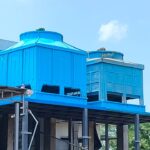
Round Type Cooling Tower
The Round Type Cooling Tower, constructed from FRP, boasts resistance to corrosion, resilience against extreme vibrations, and the ability to withstand high wind loads. Its design emphasizes efficiency
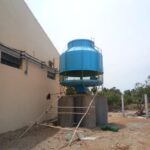
Wooden Cooling Tower
Wooden Cooling Tower are designed to handle water with high levels of dissolved solids (TDS). Hot water from the source is sprayed over special nozzles in a collection basin
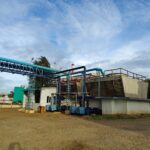
Closed Circuit Cooling Tower
Closed Circuit Cooling Tower is a type of heat exchanger that combines the functions of a cooling tower and a heat exchanger in a single unit.

Dry Cooling Tower
Dry Cooling Towers is a type of cooling system used in industrial and power generation processes to remove excess heat without the need for water.
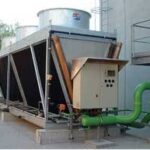
Evaporative Cooling Tower
Evaporative cooling tower are devices used to remove excess heat from industrial processes, power plants, and HVAC systems by using the principle of water evaporation.
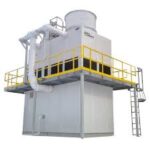
Natural Draft Cooling Tower
Natural draft cooling towers are a type of cooling tower that uses the natural convection of air to cool water.

Cooling Towers We Exported to
Cooling Towers We Export to Iceland
Cooling Towers We Export to Ireland
Cooling Towers We Export to Italy
Cooling Towers We Export to Johor
Cooling Towers We Export to Kedah
Cooling Towers We Export to Kelantan
Cooling Towers We Export to Khulna
Cooling Towers We Export to Kosovo
Heat Exchangers We Exported to
Heat Exchangers We Export to Coahuila
Heat Exchangers We Export to Colima
Heat Exchangers We Export to Croatia
Heat Exchangers We Export to Cyprus
Heat Exchangers We Export to Czech Republic
Heat Exchangers We Export to Dagestan
Heat Exchangers We Export to Denmark
Heat Exchangers We Export to Dhaka
Industrial Chiller We Exported to
Industrial Chiller We Export to Lithuania
Industrial Chiller We Export to Luxembourg
Industrial Chiller We Export to Malacca
Industrial Chiller We Export to Malta
Industrial Chiller We Export to Moldova
Industrial Chiller We Export to Monaco
Industrial Chiller We Export to Montenegro
Industrial Chiller We Export to Mymensingh
